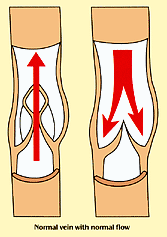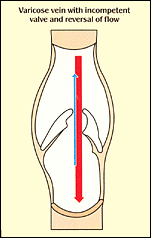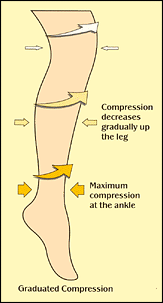About Futuro: Support Hosiery
Tables of Content
- Venous leg disorder - An overview
- The role of Support Hosiery
- Futuro® Support Hosiery
- Information for Customers
1. Venous Leg Disorder - An Overview


Venous leg disease occurs when valve and/or muscle function is compromised, the blood is not returned to the heart, and as a result, there is a back flow of blood into the veins of the lower legs.
Normal Venous function
Normal venous function in the legs depends on healthy valves within the veins and adequate stimulation of veins via activity of calf and leg muscles.
Compromised Venous function
The accumulation of blood and fluid in the lower leg puts undue stress on the veins, resulting in a range of signs and symptoms, depending on the severity of disease.
When blood stagnates in the veins it can lead to thrombosis (blood clot formation). Such clots may break off and travel to distant sites in the bloodstream in a process called thromboembolism.
Symptoms
Mild Venous Disorders:
- Tired, heavy, achy legs
- Slight swelling of ankles
Severe Venous Disorders:
- Swelling of ankles & feet (edema)
- Spider* & varicose veins
- Cramping and/or sharp pains in the leg
- Discoloration of the skin which may result in ulcerations (open wounds)
* Spider veins could potentially be a symptom of severe venous disorders.
Common Risk Factors
- Gender - Women are more often affected with venous leg disease than men.
- Age - Incidence increases with age; estimated incidence of venous insufficiencies including varicose veins, is as high as 50% in people 50 and older.
- Weight - Excessive weight increases strain on veins.
- Level of Ambulation - Weak and inactive leg muscles provide insufficient stimulation of veins, especially when semi or partially bed-ridden.
- Heredity - Evidence shows that varicose veins tend to run in families.
- Previous Injury or Surgery - Hip operations, and/or injury to the legs and hips increase the likelihood of abnormal clotting of blood (thrombosis) in the veins.
- Pregnancy - May be a risk factor due to the increased weight on the iliac vein, as well as hormonal changes.
- Occupation / Lifestyle - Jobs or lifestyles that require standing or sitting for prolonged periods may increase risk.
- Previous Episodes of Thrombosis - People with deep vein thrombosis (DVT) are likely to develop venous leg disease.
2. The role of Support Hosiery - Indications, Benefits, Styles
Indications
Support hosiery is thought to help improve or prevent symptoms of mild to severe venous leg problems. It is recommended as part of the treatment for all stages of venous leg problems, from achy, tired legs to severe varicosities. Support hosiery has also been shown to help prevent development of the post-thrombotic syndrome in people with previous deep vein thrombosis (blood clots).

Figure 1
Graduated Compression - Mechanism of Action
Support hosiery is specially designed to exert pressure on the legs, with the highest amount of pressure exerted at the ankle and a gradual decrease in pressure up the leg.
This design is referred to as graduated compression. (See Figure 1)
Graduated compression may help improve venous function by:
- Reducing back flow of venous blood in the lower legs
- Reducing the diameter of the veins and increasing the velocity of blood flow
- Improving lymphatic flow
- Preventing seepage of fluid out of the veins into surrounding tissue
Benefits
For people with mild, moderate, or severe venous leg problems, support hosiery may:
- Relieve leg pain and fatigue
- Reduce or prevent swelling of feet, ankles, and lower legs
- Help prevent progression of venous disease and development of associated problems, such as varicosities, skin discoloration, and ulcerations
- Help prevent formation of thrombi (blood clots)
Styles of Support Hosiery *
- Knee-high ** Appropriate for most cases of venous leg problems. Comfortable and easy to wear.
- Thigh-high ** May be required in patients with varicosities or thrombophlebitis above the knee. May also be used in place of knee-high stockings for wear with skirts or dresses.
- Casual and Dress Socks ** Appropriate for men and women with varicose veins or venous leg problems. Athletic socks have cushioned sole for active comfort.
- Pantyhose (Waist-high) May be worn in place of knee-high or thigh-high stockings for wearing with skirts or dresses. Individuals with symptoms / disorders above the knee will benefit from wearing this style.
- T.E.D. Anti-Embolism Stockings Recommended for mobility-impaired individuals at risk of thromboembolism. Knee-high & thigh-high styles available.

* The above styles are typically available in support hosiery. Most styles are available in both mild and firm levels of compression for men and women.
** When wearing knee-high and thigh-high styles, care should be taken to avoid constriction of the leg. Tight or turned-down elastic bands may create a tourniquet effect and interfere with circulation.
T.E.D.® is a registered trademark of TYCO Healthcare Group LP
3. Futuro® Support Hosiery
Futuro® offers support hosiery in three different levels of compression to assist in treating mild to more severe venous leg problems. To enhance compliance, FUTUR0® support hosiery is designed for optimum comfort and fit, and is available in a variety of colors and styles for both men and women. Choosing the right compression level and style depends on the individual's type of venous disorder, lifestyle and preference.
Futuro® Mild Support (8 - 15 mmHg)
Recommend for the following symptoms:
- Mild degrees of fired, achy legs
- Slight ankle swelling
- Mild varicosities during pregnancy
- Mild leg swelling after cast removal
Futuro® Firm Support (20 - 30 mmHg)
Recommend for the following symptoms:
- Moderate to pronounced tired, achy legs (heaviness)
- More severe ankle swelling
- Moderate to pronounced spider and varicose veins
- Painful legs and/or moderate varicose veins during pregnancy
- Support after uncomplicated vein stripping in ambulatory patients
- Reversible mild lymphedema
- Post phlebitic syndrome
- Pronounced leg swelling after cast removal
T.E.D.® Anti-Embolism Stockings (18mmHg)
Generally worn on the advice of a physician for:
- Prevention of thromboembolism
- Mobility-impaired people at risk of thromboembolism
NOTE: Ambulatory people at risk of thromboembolism may need a higher level of compression. Check with physician for proper compression level
4. Information for Customers
Unraveling the "Myths" About Support hosiery:
| Myth: | Support hosiery is only a last resort treatment for serious venous leg conditions. |
| Fact: | In people with mild to moderate venous leg conditions, support hosiery can be helpful in relieving tired, achy legs, and swelling. |
| Myth: | Support hosiery is ugly and unfashionable. |
| Fact: | Support hosiery comes in styles, textures and colors similar to those of regular socks and hosiery. In fad, certain styles look and feel like regular hosiery; only you will notice the difference! |
| Myth: | Support hosiery is hot and uncomfortable to wear. |
| Fact: | Support hosiery is often sheer, stylish and designed to be as comfortable as possible. The key to optimum comfort is proper fitting and sizing. |
Do's and Don'ts of Support Hosiery
| Do | Follow the advice of your physician or healthcare provider and the manufacturers' directions when selecting the size and style of support hosiery. Ill-fitting hosiery may worsen your problem. |
| Do | Follow the manufacturers' advice about care and washing to extend the life of hosiery. It is best to keep two pairs of support hosiery on hand so that you have a pair to wear while the other is being washed. |
| Do | Put hosiery on first thing in the morning before getting out of bed (for those with more severe venous leg disorders). |
| Don't | Use elastic bandages in place of support hosiery, unless specifically directed by your physician. Improper use of an elastic bandage can cause uneven compression and may worsen your problem. |
| Don't | Wear support hosiery to bed unless specifically recommended by your physician or healthcare provider. |
| Don't | Turn down elastic band when wearing knee high, thigh high or anti-embolism stockings. This may create a tourniquet effect and interfere with circulation. |
| Don't | Dangle legs over the side of bed while putting hosiery on (for those with more severe venous leg disorders). |
Prevent or Relieve Symptoms of Venous Leg Disorders
There are many simple lifestyle modifications that can reduce the risk of or prevent the progression of venous leg disease, including:
- Stay active e.g. walk. dance, swim. Activity helps keep calf muscles strong and stimulates venous blood flow.
- Avoid wearing high heels Wearing high heels may interfere with normal contraction of calf muscles.
- Elevate legs Raising the legs above the heart for 15 to 20 minutes a day can help reduce swelling. Individuals with severe disease may benefit from elevating the foot of the bed 2-3 inches.
- Maintain a healthy body weight Being overweight puts extra strain on the veins of the legs and increases the risk of venous leg disease.
- Avoid standing still or crossing legs for prolonged periods When standing - shift your weight or flex and release your calf muscles. When sitting - flex your ankles, but avoid crossing your legs.
For moderate to severe varicose veins, your physician or healthcare provider may suggest therapies such as sclerotherapy, or surgery. Even with these therapies, your physician or healthcare provider may recommend continued use of support hosiery. Therefore, do not discontinue use of support hosiery unless advised by your physician or healthcare provider.
Frequently Asked Questions:
- What are Varicose Veins?
Varicose veins are abnormally widened, and lengthened segments of the veins below the surface of the skin. They are commonly found on the inside or back of the legs and occasionally on the thighs, and are usually associated with a problem in the free flow of the blood in those affected veins.
- What Causes Varicose Veins?
Causes of varicose veins are not entirely understood. Heredity, weakness in the wall of the vein or the valves, congenital absence of the valves, gender, hormonal changes, and our upright position are the most common factors cited.
A raised pressure inside the vein causes it to dilate. This pressure is typically from the forces of gravity, the body's weight, and the column of venous blood that has not yet finished its trip back to the heart. This is often due to valves in the skin veins and associated connecting veins not functioning correctly thereby allowing increased volumes of blood to accumulate in the affected veins under increased pressure. This extra volume of blood must be accommodated and the veins therefore, widen.
In simple terms, it is rather like blowing air into a balloon where the air cannot flow out again, and the balloon swells. A vein also has a certain elasticity in the walls and swells in the same way. Varicose veins are often very obvious, appearing swollen and, sometimes, quite discolored. The swollen veins contain blood that is not flowing properly and 'static' blood is not a healthy situation. Additionally, these veins can cause discomfort and can bleed copiously if damaged - even by simply scraping or knocking against the furniture. There seems to be a hereditary tendency to varicose veins, but the condition is exacerbated by prolonged standing, obesity, pregnancy, and activities that induce high abdominal pressure (weight lifting, playing a wind instrument, and very tight clothing). Damage to the valves after a deep vein thrombosis (blood clot formation) can also lead to varicose veins. Check with a physician.
The problem is extremely common in both sexes and increases with age. - What Are The Common Symptoms Of Varicose Veins?
Many people have no symptoms other than possibly unsightly veins, causing cosmetic concern when wearing shorts or bathing suits. Symptoms may vary from minimal to severe and include the feeling of heavy legs, drawing pains, night cramps, swelling, tenderness to touch, and itching. Symptoms tend to worsen as the day goes by. In women, these symptoms are often made worse around the time of menstruation.
Untreated, varicose veins can lead to the following complications:
- Marked irritation of the skin around the ankle with brownish discoloration (stasis dermatitis)
- Blood clots (thrombi)
- Leg ulcers (breaks in the skin)
- Bleeding
- Infection
- When Should I See A Doctor?
If you have questions regarding varicose veins, or any other veins you think may be a problem, speak to your doctor during your annual physical. If your varicose veins are very bothersome, or if ulcers begin to develop, speak to your doctor immediately.
- What Are Spider Veins?
Spider veins are visible thread-like colored veins ( medically referred to as telangiectasia ) which are actually localized dilations of the veins of the skin which tend to occur most commonly on the face and on the legs. Increased pressure is not as important a factor in causing spider veins as in varicose veins. Hormonal influence of the female hormone estrogen is the most likely reason why these spider veins are seen more commonly in females, especially during or after pregnancy, when taking oral contraceptives, or when on estrogen replacement therapy. Heredity is another significant factor. While not harmful, they can cause a great deal of distress to those who have them, particularly in the summer, or on vacation when affected areas are more exposed. This is, however, unnecessary, as the condition is quite amenable to treatment. They are not as painful as enlarged varicose veins but they are still liable to bleed and worsen without treatment.
- Why Should I Treat Varicose Veins?
A successful treatment allows the venous side of the circulatory system to be improved. The blood that was pooled in the varicose vein is made available to the general circulation by being forced to enter into other healthy veins. Symptomatic patients should expect relief if their symptoms were related to venous insufficiency (other causes of leg pain are sciatica, arterial problems, and arthritis). Asymptomatic patients will be satisfied with their new look.
- What Is Support Hosiery?
Support hosiery is hosiery (pantyhose, stockings, and socks) that is specifically designed to help individuals with venous or circulation disorders. Support hosiery uses graduated compression to help prevent swelling, reduce pain, and provide more comfort to patients who are suffering from varicose veins, spider veins, edema, and other leg disorders.
Graduated compression means there is a significant amount of pressure exerted in the ankle of the stocking, and this pressure is eased up the stocking leg. Individuals who wear support hosiery will notice that the stocking will feel snug at the ankle, but this pressure will gradually decrease up the calf and to the thigh. Using support hosiery will promote circulation of the blood, and may prevent some of the problems associated with poor circulation, such as blood clots, venous leg ulcers, recurrent varicose veins and skin discoloration.
Support hosiery spans a broad range of styles, compression levels and materials for both men and women. Individuals should consult with their pharmacists or physicians to determine what the appropriate level of compression and style is for them. Support hosiery can be purchased as ready-to-wear or custom fit hosiery. Ready-to-wear support hosiery is typically available at local pharmacies, drug, grocery, or mass merchandise stores. Custom fit hosiery is more likely available at an independent pharmacy or medical dealer shop.
- When Should I Consider Wearing Support Hosiery?
You should consider wearing support hosiery if you are suffering from fired, achy legs, ankle swelling or varicose veins. If you feel that your problem is more serious, it is important that you visit your physician.
- How Do I Know Which Support Hosiery To Purchase?
Support hosiery is available in different levels of compression (Compression is expressed in millimeters of Mercury, or mmHg). Individuals should work with their pharmacist or physician to determine what level of compression is appropriate.
- Mild Compression Hosiery - 8-15 mmHg is ideal for fired, achy legs, and slight ankle or foot swelling.
- Firm Compression Hosiery - 20-30 mmHg and above - is available for individuals who experience more prominent and severe problems due to venous disease such as, spider* or varicose veins, swelling of ankles and feet. cramping or sharp pains in leg, and skin discoloration which may result in ulcerations.
Article Links
See other medical related articles:- About Futuro: Support Hosiery
- About Mediven Compression Stockings
- About T.E.D. Anti-embolism Stockings
- Compression Classes for Graduated Compression Hosiery
- Prevention of Deep Vein Thrombosis (DVT)
- Skin Breakdown and TED Stockings
- Taking good care of your legs
- TED Stockings: Proven DVT reduction through published peer reviewed clinical studies
- Tips and Tricks for Healthy Legs
- Veins of the Leg
- When a blood clot forms in the leg ... (.jpg, 119Kb) The Sunday Times, 30 December 2001
- CE Marking (European Medical Device Directive 93/42/CEE)












